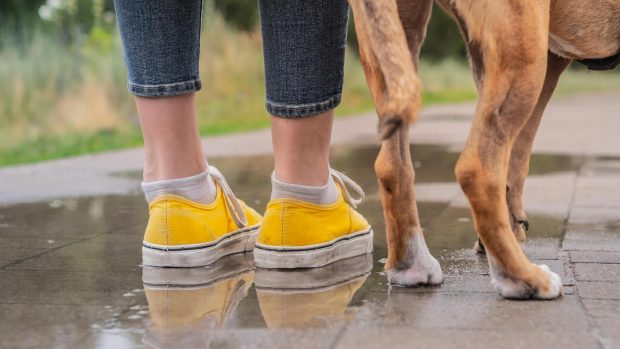Summer brings so many benefits for dog owners. Less mud, fewer layers to wrap up ourselves (and our dogs) against the elements, and longer days giving us more time to go for walks. But a heatwave brings uncomfortably high temperatures, and anyway not all dogs enjoy the warmth. Some breeds of dog are designed to live in much chillier climes – for instance Huskies, who lie down on the snow like they’re on the hearth. While dogs have two different types of sweat glands, they cannot produce enough sweat to lower their body temperature effectively, so they also pant and release heat through their noses and paw pads, so it’s really important not to let your dog overheat. At one extreme would be leaving your dog in the car on a warm day, but knowing how to keep your dog cool in summer goes much further than that.
Helen Masters is a fully qualified dog behaviourist, rehabilitator and trainer based in Kent, who has built up her knowledge and experience over the past 20 years. She agrees that different breeds cope differently with the heat.
“Some dogs do actually like to sunbathe, the Mastiffs and my old Rhodesian Ridgeback adored it,” she says. “They were supplied with plenty of shade and the large dog paddling pool was on hand for a drink and a dip.”
Breeds likely to suffer the most on hot days are the brachycephalic breeds, such as bulldogs, pugs, Pekingese – breeds with flat faces and small nostrils can have breathing problems on normal days, and therefore walking them in hot weather is a greater risk.
How to keep your dog cool in summer
Exercise
There are various aspects to a dog’s daily routine that could be impacted by hot weather. Walking is the obvious one, because exercise increases the body temperature, and it takes place outside under the sun – and “when is it too hot to walk a dog?” is often asked. The phrase “mad dogs and Englishmen go out in the midday sun” is worth remembering – do not walk when the sun is high in the sky. Helen points out that the number of heatstroke cases in dogs recorded at her local vets during the 2022 heatwave was double the norm.
“No dog ever died from not missing a walk!” she says. “If it’s hot like that, either walk your dog at 5am or 9–10pm. Walking even in covered shade, like woodland, is infinitely cooler but still not advisable on hot days, not only for heatstroke and exhaustion, but any stagnant water will be brimming with harmful bacteria whether ingested or paddled in. The risk of bites and stings is also much higher.”
Helen recommends using a good horse fly repellent, as well as dog-friendly suncream, especially on dogs with short or white coats.

Petkin Doggy Sunmist | Amazon.co.uk
Simply spray this on for instant sun protection. It compares to SPF15 on human sunscreens.
Take into account, too, the surface you will be walking on and use the “touch test”. Place the back of your hand or your inner wrist on the surface and imagine the effect it has on your dog’s paw pads. Concrete can feel like an oven on a hot day and lead to burns and blistering on the paws.
Keeping a dog cool during playtime
Rather than sticking to the daily walk, you can offer him mental enrichment at home. A puzzle toy or long-lasting dog chew may provide some stimulation and distraction if he’s used to going out at the same time every day – or perhaps you could teach him some tricks instead.
If you’re going to head out for a walk or even just for coping with the atmospheric heat in the home and garden, Helen recommends a dog cooling jacket, combined with cooling mats to absorb their body heat while they rest. Hosing your dog is another good way to cool him down quickly, but always check the temperate of the water in the hose before putting it on your dog to avoid any risk of accidental scalding.

Ruffwear Dog Cooling Vest | Amazon.co.uk
Wet it, put it on and go. This vest has three-layer construction for maximum cooling and it works by cooling by evaporation (in the same way that human sweating works). Available in six sizes.

Pecute Dog Cooling Mat | Amazon.co.uk
This mat works by absorbing your dog’s body heat. It is waterproof, scratch-resistant, and wear-resistant. Available in six sizes.
“For dogs that love water and a paddle, dog paddling pools that are now available are a godsend,” says Helen. “I often put balls or dog toys in there for them to splash about with. I find that dogs who hate water will still have fun with a bucket and toys dropped in.”
Another treat that will help lower the body temperature is home-made “doggy ice lollies”. Helen cautions: “Do not go overboard with too many frozen fruit and meat cubes as well as their normal food, as this can give them stomach-ache and diarrhoea.” You can also add ice cubes to their drinking water to prevent dehydration; dogs usually don’t like to drink warm water. For dogs fed a raw dog food, feeding it to them frozen acts like a cooling aid, while also providing enrichment as they have to work harder for their food. Little and often is key, as many dogs will lose their appetite in hot weather.
When is it too hot to take a dog for a walk?
There isn’t a straight answer, because it largely depends on the type of dog you have and their individual needs. However, as a rough guide, when the temperature is…
- 15º – there’s no risk walking any dog
- 18º – smaller to medium dogs won’t be affected, but larger, hairier dogs should be monitored in case they begin exhibiting signs of heat exhaustion. However, it is unlikely to occur
- 21º – small to medium dogs are unlikely to experience ill effects, but there is a potential hazard for larger dogs
- 23º – potential hazard to all dog types. Dogs should be monitored and exercise routine adjusted accordingly
- 26º – potential hazard to small and medium dogs. Dangerous for larger dogs – avoid walking
- 29º – heat this intense poses a danger to all dogs, but is life-threatening to larger dogs. Care should be taken to adapt your dog’s exercise routine to ensure his walk is undertaken at a comfortable temperature
What dog breeds are more at risk of heatstroke?
Dogs with dark and black coats feel the effects of the heat more intensely, as well as thick-coated breeds such as Siberian Huskies, Samoyeds and Bernese Mountain Dogs. If you have a brachycephalic (flat-faced) breed, such as a pug, bulldog or boxer, you should take extra care that they are breathing normally. Brachycephalic dogs have shorter snouts, and cannot pant as effectively as longer-nosed dogs. Therefore, it is harder for them to regulate their body temperature in extreme heat.
What are the signs of heat stroke in dogs?
If your dog is showing any of the following signs, get him out of the heat, apply cold water all over his body, then take him straight to the vet.
- Body temperature above 40ºC
- Excessive panting, with dark or bright red tongue, sticky or dry tongue and gums, excessive drooling
- Staggering, stupor, and at worst seizures, disorientation, lethargy and anxiety
- Rapid heartbeat, wobbly legs, collapsing
Stay safe, and enjoy the sunshine!
You may also enjoy reading…

Is it too hot to walk your dog? Here’s how to make your summer strolls safe

Best dog cooling mats for hot and bothered pooches

Hydrate and be healthy: best water fountains for dogs

Subscribe to Horse & Hound magazine today – and enjoy unlimited website access all year round
Horse & Hound magazine, out every Thursday, is packed with all the latest news and reports, as well as interviews, specials, nostalgia, vet and training advice. Subscribe today and enjoy the magazine delivered to your door every week, plus unlimited website access and digital versions of the magazine dating back to September 2012.




